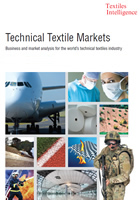Issue
66:
3rd quarter 2006

Product Overview
Buy this Report now
Buy this Issue now
Subscribe
Download brochure (PDF)
Download price list (PDF)
Price list download
| Please choose your preferred currency:
|
Request sample issue
View list of reports
in other issues
|
Multi Report Package |
We also offer a flexible subscription product,
the Multi Report Package,
which allows you to select your own choice of reports from our full range,
to suit your own budget.
Click here for full details.
|
|
 |
Architectural Textiles: World Cup Showcase in 2006 and Beyond |

16 pages,
published in Issue 66, 3rd quarter 2006
Report price:
Euro 395.00;
US$ 520.00
|
The 2006 World Cup served as a showcase for the extensive use of architectural textiles in Germany. Many of the stadiums which hosted world cup matches feature roofing and support structures made from high performance textiles. Furthermore, two of the world?s largest companies which design and construct buildings using architectural textiles, Hightex and Covertex, have their headquarters in Germany.
Textiles have a number of advantages over conventional roofing materials?such as prefabricated hard panels of metal or plastic. The advantages include flexibility, light weight, low cost and high coverage. These properties enable architects to incorporate wider and longer panels into their designs.
Today, the use of textiles in architecture is commonplace throughout the world in a number of structures, including public buildings, auditoria, open-air theatres, railway stations, airports, shopping centres, parks and landscaped spaces, entrances and walkway areas.
Architectural textiles are usually made from woven polyester fabric coated with polyvinyl chloride (PVC), although other synthetics and coatings can be used. For special properties and enhanced durability, fibreglass fabric coated with polytetrafluoroethylene (PTFE) can be employed. In addition, pneumatically pre-tensioned ethylene tetrafluoroethylene (ETFE) film or sheeting offers a number of design possibilities at relatively low cost.
Key fabric manufacturers supplying the architectural textile sector include Ferrari in France, Sattler in Austria and Verseidag-Indutex in Germany.
| Four times a year, Technical Textile Markets provides an overview of the global man-made fibre, nonwoven and technical textile industries. It provides market data and analysis of new and established markets for technical textiles, and is essential reading for senior executives in (or supplying) the man-made fibre, nonwoven and technical textile sectors ? as well as for those who are not involved in the industry on a day-to-day basis, but who need an authoritative source which helps them to quickly gain an understanding of the key issues facing the companies which are actively involved in this fast-growing sector. |  | | Reports in Technical Textile Markets include: |  | company and country profiles ? giving you the opportunity to learn from strategies employed by others, in terms of production, sourcing, import/export, infrastructure and development, and plans for the future. |  | profiles of the world's top 40 producers of nonwovens ? updated each year with details of developments from each of the leading producers, including acquisitions, investments and divestments, and analyses of trends which the "rising stars" are using to their advantage. |  | statistical reports ? including consumption data, by fibre and end-use applications. Regular updates are published for fibre consumption in Japan, the rest of Asia, the USA, and Western Europe. |  | market sector information ? analyses of important commercial end-user applications, and profiles of both established and emerging markets which take into account such innovations and developments as nanotechnology and intelligent textiles. |  | regular updates on innovations in fibres, technical textiles, apparel and machinery ? including developments in the following categories: fibres and yarns; technical textile fabrics for industrial applications; machinery; technical textiles for apparel; composites; other technical textile products; and technical textile treatments and finishes. |  | reports on new technological developments and other topical issues ? with clear, authoritative comments on their economic and commercial significance. The reports bring to your attention the key issues which you can use to develop your business, and provides contact details of useful organisations. |  | | So whether you are involved in man-made fibres, nonwovens or technical textiles ? in manufacturing, converting, import/export, or end use ? or if you are in education or consultancy or investment or finance ? a subscription to Technical Textile Markets will tell you what you need to know about the key trends in the industry. |  | | Technical Textile Markets is available on subscription ? either in printed format only, or in printed and electronic format. If you choose the printed only option, you will receive 4 printed publications a year. Each issue contains five research-based reports (see above) and an editorial. |  | Electronic supplement
If you choose the printed and electronic option, you will receive an extra service. You will still receive each issue in printed format, delivered to you by traditional post. In addition, you will be able to download PDF files containing the same information ? but the PDF files will be available immediately on publication, so you don?t have to wait for the printing and mailing. You also have all the benefits of electronic files: instant access even when you are away from the office; convenient storage in your PC or laptop; portability; electronic search facility; and copy/paste facility. You will also receive a monthly update of business news, called "Technical Textiles Business Update" delivered to you by email, free of charge. |  | | Technical textiles are used in a wide range of end-use applications and markets, including agricultural; automotive; building/ construction/ engineering; medical and hygiene; packaging; protective clothing; sports and sportswear; and transport. A subscription to Technical Textile Markets will support your decision making, and provide the information you need to expand into new markets. |  |
| This is what our customers say: |
| "We are indeed impressed with the quality of the information contained in
your reports." |
| (Miguel ARISTIZÁBAL; Marketing Support & Foreign Trade Affairs; Enka de Colombia S.A.) |
|
